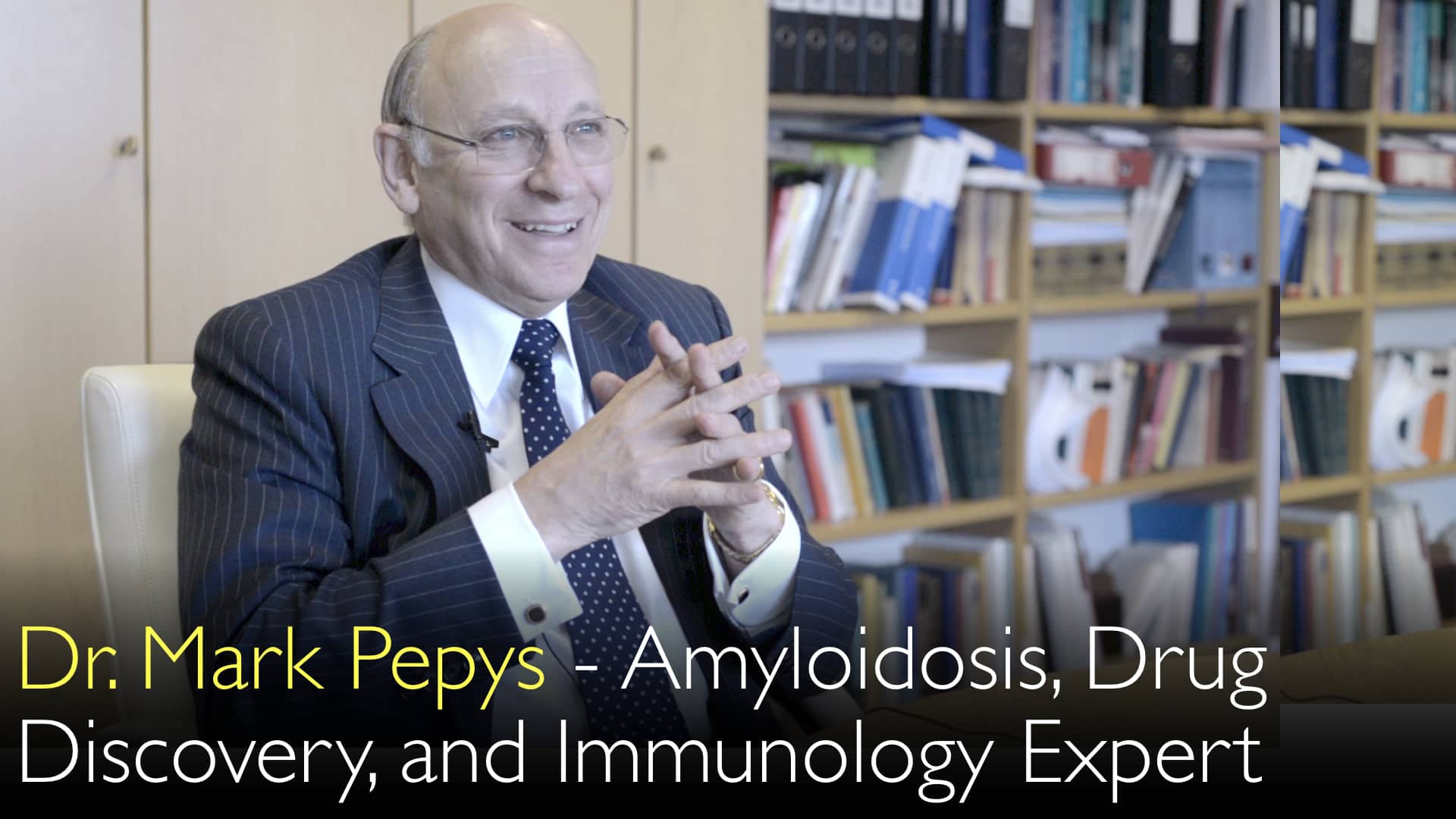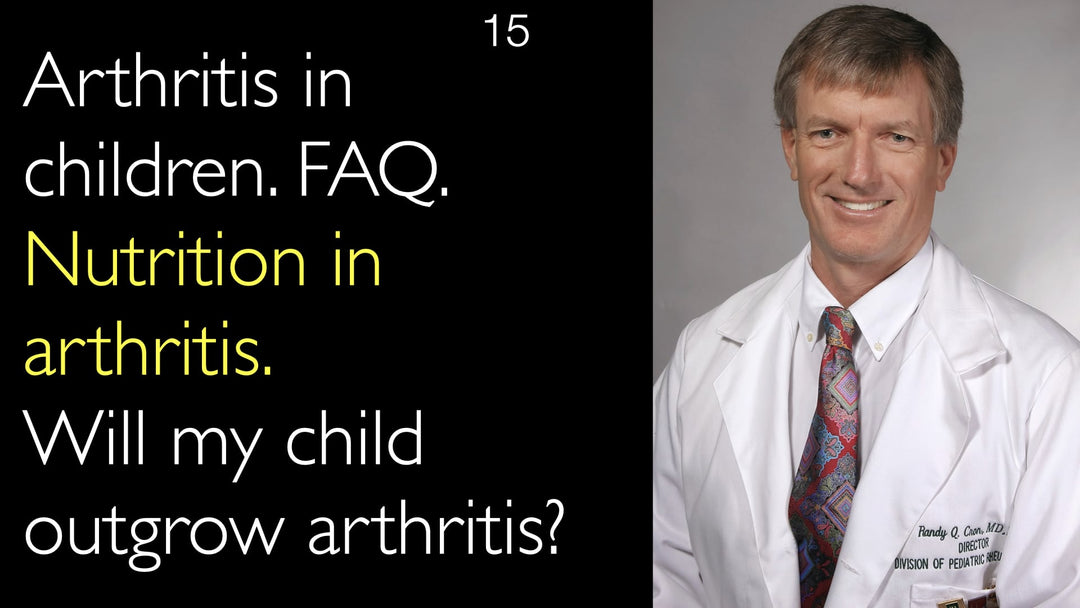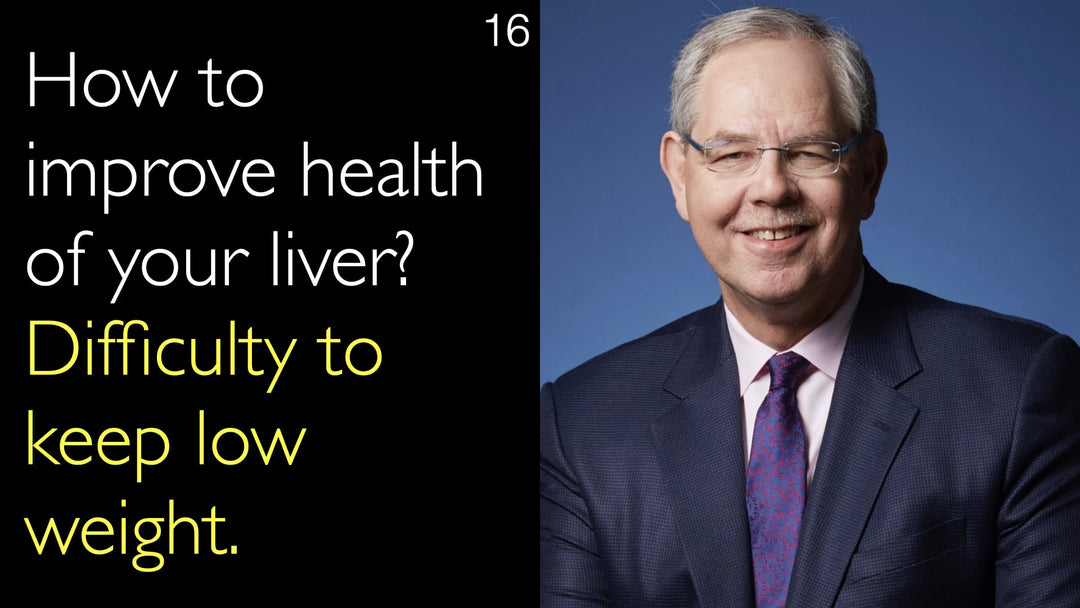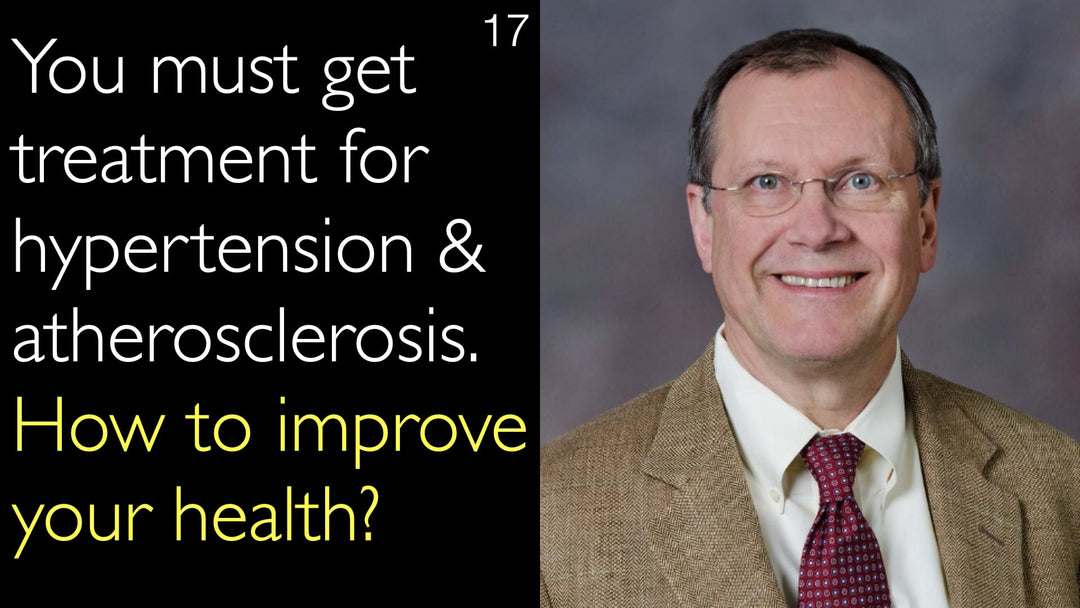Leading expert in amyloidosis therapy, Dr. Mark Pepys, MD, explains his groundbreaking research into a novel treatment method. His work focuses on the serum amyloid P component (SAP) protein that coats all amyloid deposits. Dr. Pepys developed a two-step therapy that first depletes SAP from the blood. A second antibody then targets residual SAP on amyloid fibrils. This triggers the body's natural mechanisms to remove the harmful amyloid. Clinical trials show this approach is safe and can dramatically clear amyloid from organs.
Innovative Two-Step Treatment for Amyloidosis Removal
Jump To Section
- Understanding Amyloid Biology
- SAP Protein Role in Amyloid Persistence
- Initial Treatment Development
- Clinical Trial Results and New Hypothesis
- Breakthrough Antibody Therapy
- Current Development Status
- Full Transcript
Understanding Amyloid Biology for Treatment
Dr. Mark Pepys, MD, emphasizes that understanding disease pathobiology is the key to devising new treatments. For amyloidosis, this meant investigating why specific proteins misfold and form amyloid fibrils. Dr. Anton Titov, MD, discusses the importance of understanding how these fibrils damage tissues and why the body fails to remove them. This foundational research into the underlying biological abnormality was the critical first step that informed all subsequent therapeutic development.
SAP Protein Role in Amyloid Persistence
A major discovery was the constant presence of serum amyloid P component (SAP) on all amyloid deposits. Dr. Mark Pepys, MD, discovered that SAP binds to amyloid fibrils in a calcium-dependent manner. His research provided convincing evidence that this binding contributes to both the formation and persistence of amyloidosis. The SAP coating effectively camouflages the amyloid, making it appear normal to the body's scavenging cells. This prevents the natural clearance of the harmful material from organs and tissues.
Initial Treatment Development and Challenges
In the 1980s, Dr. Mark Pepys, MD, conceived the idea of separating SAP from amyloid deposits as a therapeutic strategy. He identified a small molecule, later named CPHPC, that could achieve this dissociation in laboratory settings. Initially, pharmaceutical companies showed little interest due to amyloidosis being a rare disease. However, the link to Alzheimer's disease, which involves brain amyloid, later spurred investment. A collaboration with Roche led to the development of CPHPC, a medication designed to remove SAP.
Clinical Trial Results and a New Hypothesis
The first human trials of CPHPC involved 30 patients with systemic amyloidosis treated for one to two years. Dr. Mark Pepys, MD, reports the medication was "wonderfully safe" with no adverse effects. It successfully removed virtually all SAP from the blood within a day through a novel pharmacological mechanism. However, while it removed a lot of SAP from the amyloid deposits, some always remained, and the amyloid itself did not go away. This result led Dr. Pepys to formulate a new, major therapeutic idea.
Breakthrough Two-Step Antibody Therapy
The new hypothesis involved a two-step treatment for amyloidosis. First, CPHPC depletes SAP from the blood. This crucial step enables the second phase: administering an antibody specifically designed to target the residual SAP left on the amyloid deposits. In transgenic mouse models, this combination therapy was 100% reproducible. A single dose of the antibody triggered the complete removal of all amyloid, "like magic," without harming the animals. This dramatic success proved the concept that the body's immune system could be harnessed to clear amyloid.
Current Development Status and Future Trials
The invention was licensed to GlaxoSmithKline for commercial development. A Phase 1 study published in the New England Journal of Medicine in 2015 showed extremely promising results. In patients, the treatment progressively and dramatically removed amyloid from the liver, spleen, and kidneys. The therapy has been safe and well-tolerated. Plans are now advancing for a Phase 2 clinical trial. This next study will specifically include patients with cardiac amyloidosis, the most serious and challenging form of the disease to treat.
Full Transcript
Dr. Anton Titov, MD: Over the last 40 years, you have been on the discovery path of a particular method to treat amyloidosis. Could you please describe in more detail your method of amyloidosis treatment? What is the discovery that you have made?
Dr. Mark Pepys, MD: My treatment method, or any treatment, is firstly to understand the pathobiology of disease, including amyloidosis. It is key to devise new treatment for any disease.
Dr. Anton Titov, MD: What is the underlying abnormality in the biology? What is the functioning of the person who has become ill with amyloidosis?
Dr. Mark Pepys, MD: In the first place, I have been studying that for many years. What are the processes involved in amyloid formation? Why do these proteins misbehave in the way that they do?
Dr. Anton Titov, MD: What are the properties of the amyloid once it is formed? How does amyloid damage the tissue?
Dr. Mark Pepys, MD: We came to this conclusion. Possibly one of the reasons why the body doesn't remove amyloid fibers is this: because there is always another protein associated with them. As I said before, there are about 30 different molecules—different proteins that can form amyloid fibrils in the body. We see them in different types of amyloidosis.
But regardless of the protein that makes the amyloid fibrils, there is always another protein that is bound to the protein fibrils. That protein is called serum amyloid P component, or SAP for short.
Before I started working in the field of amyloidosis, it was known that this protein was present in all amyloid deposits. It was always present, but nobody knew why SAP was there.
Dr. Anton Titov, MD: What was it doing there?
Dr. Mark Pepys, MD: My first interest in amyloid was aroused by my discovery about SAP. The protein SAP could bind to amyloid fibrils. Indeed, SAP protein could bind to a number of other things in a calcium-dependent method.
Calcium is a mineral, obviously. Everybody has calcium in their blood; you have to have it in order to be alive. Inside the body and outside the cells, there is always calcium—a reasonably abundant amount.
In the presence of this calcium, SAP binds to all amyloid fibrils. Amyloid fibrils could form anywhere in the human body, but they always have SAP coating them.
I was intrigued from the outset by this fact. All amyloid deposits contain this protein; it is always present. It is either an amazing epiphenomenon, or it has something to do with the amyloidosis.
I have been pursuing that idea for a number of years. We gradually accumulated a convincing body of evidence. Indeed, the SAP binding to amyloid fibrils contributes to both formation and persistence of amyloidosis.
We developed a lot of this evidence; other people have got corroborative evidence.
So in the 1980s, I first had the idea of trying to separate the SAP from amyloid deposits. We discovered for the first time a small molecule that could dissociate in vitro SAP from amyloid deposits in organs of people who died.
We homogenized these organs with our small chemical, then separated these two components.
I wrote a scientific article suggesting this as a possible therapeutic treatment method. Then I visited all the major pharmaceutical companies in the world. I said, "I have got a new idea for the possible treatment of amyloidosis."
Dr. Anton Titov, MD: They said to me, "What is amyloidosis?"
Dr. Mark Pepys, MD: It was a rare disease, and nobody was very interested in it. In that era, drug companies would not spend any effort on developing a treatment for a rare disease unless the disease would have a market of several hundred million pounds per year, at least.
That has changed in the decades since then. In the 1990s, we had a lot more evidence of SAP as a target of amyloidosis treatment.
I invented a high-throughput screen to screen for molecules that would do what I wanted to do: remove SAP or prevent SAP from binding to amyloid fibrils.
Then I was able to convince Roche, the pharmaceutical company in Basel. They agreed to collaborate on that. They did a screening for medications, and we found a leading molecule as a potential medication for amyloidosis.
Very rapidly and successfully, we produced a really promising medication intended to remove all of the SAP from amyloid deposits.
We just enabled them to start a drug discovery program, that was all. But the point I'm making is that at that time, 10 years after the original suggestion—when they had not even heard about amyloidosis in the 1990s—the drug companies were very interested in amyloid.
Because in the meantime, a man called George Glenner in America had identified the protein that makes the amyloid deposits in the brain in Alzheimer's disease.
I was working on systemic amyloidosis, which is very rare.
Dr. Anton Titov, MD: But Alzheimer's disease is probably the fourth or fifth commonest cause of death in the developed world. It is the most expensive by far in terms of the cost to society and families.
Dr. Mark Pepys, MD: They were very interested in a treatment for Alzheimer's disease. The fact that I was primarily interested in amyloidosis was just a side issue for them.
Of course, I would like to cure Alzheimer's disease too. We were happy to collaborate together on that.
What we developed was a molecule that looked like a potential medication. We hoped it would remove SAP from amyloid deposits in the brain in Alzheimer's disease, and also remove amyloid in systemic amyloidosis, although Roche were not so interested in that.
At the time we were ready with the medication supply, all the regulatory material was in place. Toxicology had been done. The medication turned out to be very safe and well-tolerated in animals.
We were ready to do a clinical trial. Roche pharmaceutical company decided to not pursue the development any further for reasons that affect all big drug companies: they have limited resources, and clinical trials are incredibly expensive.
Therefore, they decided this was too speculative an idea or whatever.
Dr. Anton Titov, MD: There were a number of reasons we don't need to go into, but they decided to stop it.
Dr. Mark Pepys, MD: But very generously, they let us continue to study the medication in amyloidosis. We did not study this medication in Alzheimer's disease at that stage; we studied it just in amyloidosis.
Here in this center, we gave the medication to people with systemic amyloidosis for the first time. To our astonishment, the SAP disappeared from the blood circulation of patients with amyloidosis.
This was not the purpose of our treatment. The purpose was to prevent SAP binding to the amyloid deposits; we wanted to remove the SAP that was on the amyloid deposits already.
We wanted to completely remove it because my hypothesis was that the SAP protects the amyloid from being degraded. SAP prevents amyloid from being removed by the cells that should do this.
This is still my hypothesis of amyloidosis. The body should remove amyloid from the deposits.
Exactly! The cells that do the removing of amyloid do not have any receptors; there is no recognition mechanism for SAP. So the cells see a lump of amyloid coated by SAP in the tissues; it just looks like SAP that cells meet in the blood every day.
It doesn't look like anything abnormal to cells. My hope was—and still potentially is—that we had to remove all the SAP, and then the cells would see abnormal amyloid fibril structures and get rid of amyloid fibrils in amyloidosis.
We can feed fibrils to cells in vitro, in the test tube; they remove them very nicely. But they don't do it in the body.
Dr. Anton Titov, MD: So that was the hypothesis.
Dr. Mark Pepys, MD: We gave the medications to people with systemic amyloidosis. Patients had it first; no healthy volunteer clinical trials with this molecule were done because it was a safe molecule.
In that era of drug development, the law allowed you to do that. It went straight into patients with serious amyloidosis.
They tolerated it very well; it is completely safe as far as we know. We have now got nearly 20 years of experience with that medication; it seems to be a very safe molecule.
It removed the SAP from the blood. We discovered a new pharmacological mechanism: it came about because the medication cross-links pairs of the SAP molecules in the blood and turns them into an abnormal complex.
This is recognized by the liver cells as abnormal; liver removes this abnormal amyloid complex.
As soon as you put this medication into people, the SAP concentration rapidly falls in the blood. In one day or so, SAP is virtually all gone—not removed completely because the body goes on making it, but nearly all gone.
That was a surprise and a new discovery; it was a new invention. This enabled us to patent it.
Dr. Anton Titov, MD: This is an essential first step for commercial development of a new medicine to cure amyloidosis.
Dr. Mark Pepys, MD: We hoped that this process would remove the SAP from the amyloid. It turned out the medication is not strong enough; it is not bound by SAP with high enough affinity to successfully compete with the binding of SAP to amyloid.
Our medication removes the SAP from the blood; it removes a lot of SAP from the amyloid because the amyloid-SAP interaction is reversible. But some amyloid is always left behind.
We discovered several findings in our clinical trial of 30 patients with amyloidosis who were treated for one to two years.
The medication is wonderfully safe. There were no adverse effects from the medication or from the depletion of SAP. But amyloid deposits didn't go away; this is what we wanted to happen. Amyloidosis did not go away.
We were stuck then.
Dr. Anton Titov, MD: What to do next?
Dr. Mark Pepys, MD: I thought about this. It enabled me to have a different new idea—a major method of amyloidosis therapy.
The body removes debris and abnormal things that get into the body. This is the use of antibodies. Sometimes you get bacteria in your body or viruses; the body responds by making antibodies.
These are specific proteins that recognize just that abnormal object. Then there are a whole lot of mechanisms involving many other proteins, complex mechanisms, and cells.
Antibodies can trigger the removal of target objects; antibodies bind to things that have to be removed from the body.
We had an antibody against SAP that would target amyloid deposits, but you couldn't give that to people who still had SAP in their circulation.
Our small molecule medication removed all the SAP effectively from the blood, but it did not remove all the SAP from amyloid. It enabled for the first time the possibility of giving antibodies against SAP to target the residual SAP in the amyloid deposits.
We could trigger physiological processes of removal. This was a very novel concept.
We first planned the experiment in mice. We can induce amyloid deposits in mice experimentally; mice are the only tractable experimental model for studying amyloidosis.
We set out to do this. We had the mice that were made transgenic for human SAP; they are like human beings in terms of SAP. They have mouse amyloid with human SAP on it.
We can give them our small molecule medication, then we give them a shot of antibody and see what happens.
We discussed this in the laboratory. I said to my colleagues about amyloidosis cure, "One of two things can happen. The mice could explode because we will produce terrible consequences of this reaction going on in their organs that are full of amyloid. Or the system will do what it is supposed to do."
Dr. Anton Titov, MD: This is remove amyloidosis debris.
Dr. Mark Pepys, MD: I had designed the amyloidosis antibody specifically to work in the pathway of removing the debris. That is what happened.
We did the treatment; we gave one shot of antibody to the mice. None of them died; none got sick. We looked at them a month later; all the amyloid was gone, like magic!
So that was a dramatic step forward; that was 2005. Then we had to explore it more and show it was reproducible. It is 100% reproducible; it always happened in the experiments.
Then we filed patents on the amyloidosis antibody; it could be eventually commercialized.
Eventually, in 2009, the amyloidosis invention was licensed to GlaxoSmithKline.
Between the years around 2000, we were giving the CPHPC medication—this is the name of our small molecule medication—to patients for the first time.
Between then and the later time, Roche had divested the small amyloidosis therapy molecule completely to us. We formed a spin-out company from University College London; we owned it.
We were able to license it together with the new patents on the new invention.
Dr. Anton Titov, MD: That went to GlaxoSmithKline.
Dr. Mark Pepys, MD: They are developing amyloidosis treatment for patients. So far, it looks extremely promising.
Phase 1 study on amyloidosis was reported in the New England Journal of Medicine in July 2015. We showed that patients with systemic amyloidosis were given this treatment.
A small molecule medication called CPHPC removed SAP from the blood; some SAP was left in the amyloid. A single dose, and now a couple of doses of amyloidosis medication was tried.
We've given up to three doses to some of these patients with amyloidosis. Treatment progressively removes the amyloid; it removed amyloid dramatically from the liver, the spleen, the kidneys.
We haven't tested in that first amyloidosis study patients who had major heart involvement for safety reasons, because this is a very revolutionary and unusual treatment of amyloidosis.
It has never been given before, so we were very cautious about it. So far, the medication seems to be reasonably well tolerated; it has been safe to treat amyloidosis, and it has been efficacious.
The plans are going ahead to do a Phase 2 clinical trial to treat amyloidosis. It will look at cardiac amyloidosis.
Dr. Anton Titov, MD: This is the most important thing that we need to treat. It is going to become an effective medicine to cure amyloidosis.


![Discovery of amyloidosis treatment. Leading expert in Amyloidosis therapy. 3. [Parts 1 and 2]](http://diagnosticdetectives.com/cdn/shop/products/Amyloidosis-Alzheimers-Diagnosis-Treatment-Second-opinion-Dr-Mark-Pepys_Diagnostic_Detectives_Network.004.jpg?v=1660978374&width=1080)
![Discovery of amyloidosis treatment. Leading expert in Amyloidosis therapy. 3. [Parts 1 and 2]](http://diagnosticdetectives.com/cdn/shop/products/Amyloidosis-Alzheimers-Diagnosis-Treatment-Second-opinion-Dr-Mark-Pepys_Diagnostic_Detectives_Network.004_8571b464-8996-4b2b-94a5-9f31ef43b5a0.jpg?v=1660978389&width=1080)
![Discovery of amyloidosis treatment. Leading expert in Amyloidosis therapy. 3. [Parts 1 and 2]](http://diagnosticdetectives.com/cdn/shop/products/Amyloidosis-Alzheimers-Diagnosis-Treatment-Second-opinion-Dr-Mark-Pepys_Diagnostic_Detectives_Network.004.jpg?v=1660978374&width=720)
![Discovery of amyloidosis treatment. Leading expert in Amyloidosis therapy. 3. [Parts 1 and 2]](http://diagnosticdetectives.com/cdn/shop/products/Amyloidosis-Alzheimers-Diagnosis-Treatment-Second-opinion-Dr-Mark-Pepys_Diagnostic_Detectives_Network.004_8571b464-8996-4b2b-94a5-9f31ef43b5a0.jpg?v=1660978389&width=720)





